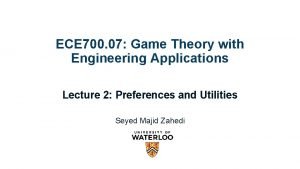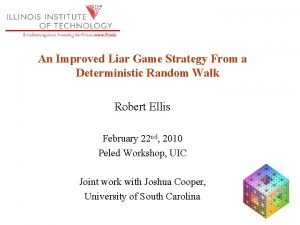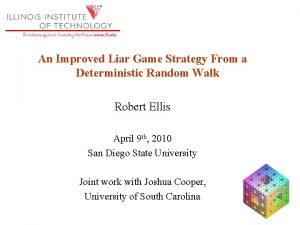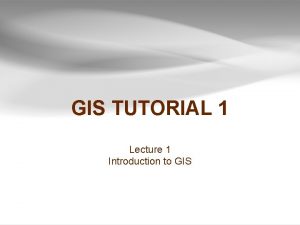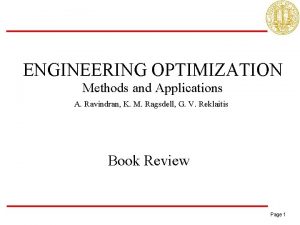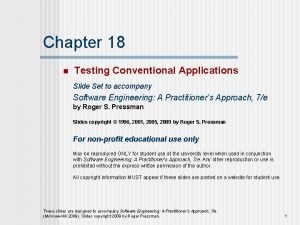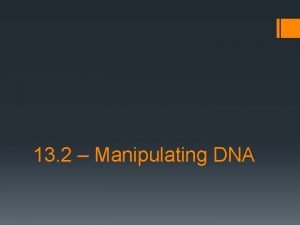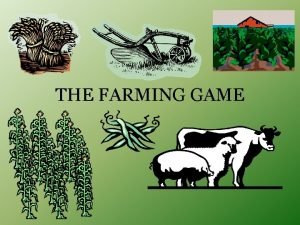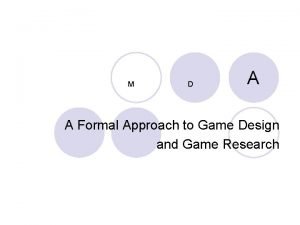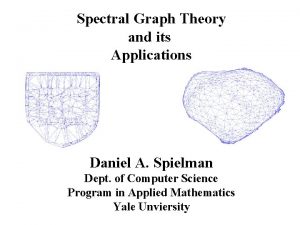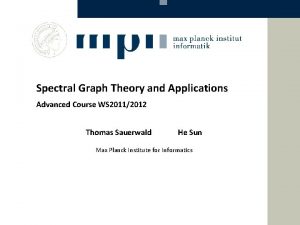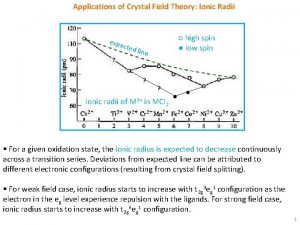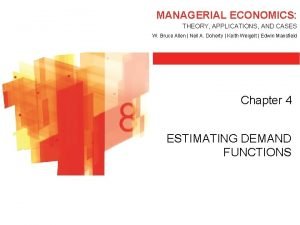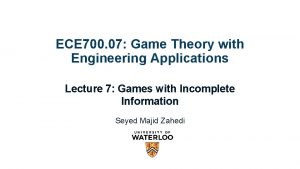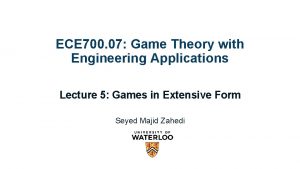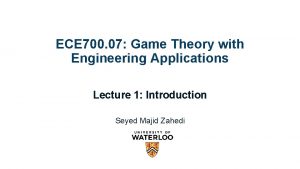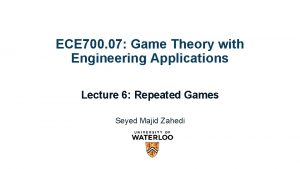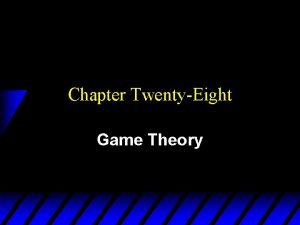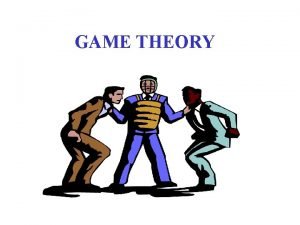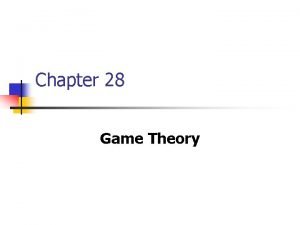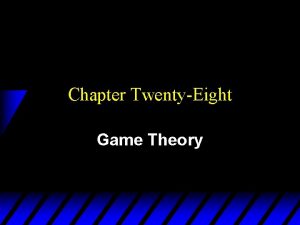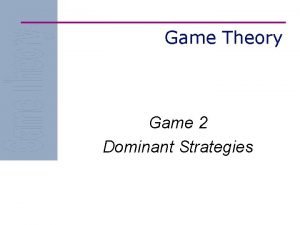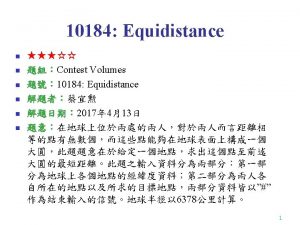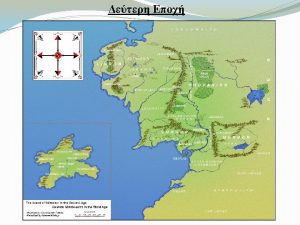ECE 700 07 Game Theory with Engineering Applications

















![Minimax Theorem [von Neumann 1928] • Each player’s NE utility in any finite, two-player, Minimax Theorem [von Neumann 1928] • Each player’s NE utility in any finite, two-player,](https://slidetodoc.com/presentation_image_h2/9f642a3f4eef44afdefd8c398357412b/image-18.jpg)






![Solving for NE using MILP (for Two-Player Games) [Sandholm, Gilpin, Conitzer AAAI 05] • Solving for NE using MILP (for Two-Player Games) [Sandholm, Gilpin, Conitzer AAAI 05] •](https://slidetodoc.com/presentation_image_h2/9f642a3f4eef44afdefd8c398357412b/image-25.jpg)



- Slides: 28

ECE 700. 07: Game Theory with Engineering Applications Lecture 4: Computing Solution Concepts of Normal Form Games Seyed Majid Zahedi

Outline • Brief overview of (mixed integer) linear programs • Solving for • • Dominated strategies Minimax and maximin strategies Nash equilibrium Correlated NE • Readings: • MAS Appendix B, and Sec. 4

Linear Program Example: Reproduction of Two Paintings • Painting 1 sells for $30 • Painting 2 sells for $20 • We have 16 units of blue, 8 green, 5 red • Painting 1 requires 4 blue, 1 green, 1 red

Solving Linear Program Graphically 8 6 4 2 0 2 4 6 8

Modified LP • Optimal solution: x = 2. 5, y = 2. 5 • Objective = 7. 5 + 5 = 12. 5 • Can we sell half paintings?

Integer Linear Program 8 6 4 2 0 2 4 6 8

Mixed Integer Linear Program 8 6 4 Optimal MILP solution: x=2. 75, y=2 (objective 12. 25) 2 0 2 4 6 8

Solving Mixed Linear/Integer Programs • Linear programs can be solved efficiently • Simplex, ellipsoid, interior point methods, etc. • (Mixed) integer programs are NP-hard to solve • Many standard NP-complete problems can be modelled as MILP • Search type algorithms such as branch and bound • Standard packages for solving these • Gurobi, MOSEK, GNU Linear Programming Kit, CPLEX, CVXPY, etc. • LP relaxation of (M)ILP: remove integrality constraints • Gives upper bound on MILP (~admissible heuristic)

Exercise I in Modeling: Knapsack-type Problem • We arrive in room full of precious objects • Can carry only 30 kg out of the room • Can carry only 20 liters out of the room • Want to maximize our total value • Unit of object A: 16 kg, 3 liters, sells for $11 (3 units available) • Unit of object B: 4 kg, 4 liters, sells for $4 (4 units available) • Unit of object C: 6 kg, 3 liters, sells for $9 (1 unit available) • What should we take?

Exercise II in Modeling: Cell Phones (Set Cover) • We want to have a working phone in every continent (besides Antarctica) but we want to have as few phones as possible • Phone A works in NA, SA, Af • Phone B works in E, Af, As • Phone C works in NA, Au, E • Phone D works in SA, As, E • Phone E works in Af, As, Au • Phone F works in NA, E

Exercise III in Modeling: Hot-dog Stands • We have two hot-dog stands to be placed in somewhere along beach • We know where groups of people who like hot-dogs are • We also know how far each group is willing to walk • Where do we put our stands to maximize #hot-dogs sold? (price is fixed) Group 1 location: 1 #customers: 2 willing to walk: 4 Group 2 location: 4 #customers: 1 willing to walk: 2 Group 3 Group 4 location: 7 location: 9 #customers: 3 #customers: 4 willing to walk: 3 Group 5 location: 15 #customers: 3 willing to walk: 2

Checking for Strict Dominance by Mixed Strategies •

Checking for Weak Dominance by Mixed Strategies •

Path Dependency of Iterated Dominance • Iterated weak dominance is path-dependent • Sequence of eliminations may determine which solution we get (if any) 0, 1 1, 0 1, 0 0, 1 1, 0 0, 0 1, 1 • Iterated strict dominance is path-independent: • Elimination process will always terminate at the same point

Two Computational Questions for Iterated Dominance • 1. Can any given strategy be eliminated using iterated dominance? • 2. Is there some path of elimination by iterated dominance such that only one strategy per player remains? • For strict dominance (with or without dominance by mixed strategies), both can be solved in polynomial time due to pathindependence • Check if any strategy is dominated, remove it, repeat • For weak dominance, both questions are NP-hard (even when all utilities are 0 or 1), with or without dominance by mixed strategies [Conitzer, Sandholm 05], and weaker version proved by [Gilboa, Kalai, Zemel 93]

Minimax and Maximin Values •

LP for Calculating Maximin Strategy and Value •
![Minimax Theorem von Neumann 1928 Each players NE utility in any finite twoplayer Minimax Theorem [von Neumann 1928] • Each player’s NE utility in any finite, two-player,](https://slidetodoc.com/presentation_image_h2/9f642a3f4eef44afdefd8c398357412b/image-18.jpg)
Minimax Theorem [von Neumann 1928] • Each player’s NE utility in any finite, two-player, zero-sum game is equal to her maximin value and minimax value • Minimax theorem does not hold with pure strategies only (example? )

Example Agent 2 Agent 1 Left Right Up (20, -20) (0, 0) Down (0, 0) (10, -10) • What is maximin value of agent 1 with and without mixed strategies? • What is minimax value of agent 1 with and without mixed strategies? • What is NE of this game?

Solving NE of Two-Player, Zero-Sum Games • Minimax value of agent 1 • Maximin value of agent 1 • NE is expressed as LP, which means equilibria can be computed in polynomial time

Maximin Strategy for General-Sum Games • Agents could still play minimax strategy in general-sum games • I. e. , pretend that the opponent is only trying to hurt you • But this is not rational: Agent 2 Agent 1 Left Right Up (0, 0) (3, 1) Down (1, 0) (2, 1) • If A 2 was trying to hurt A 1, she would play Left, so A 1 should play Down • In reality, A 2 will play Right (strictly dominant), so A 1 should play Up

Hardness of Computing NE for General-Sum Games • Complexity was open for long time • “together with factoring […] the most important concrete open question on the boundary of P today” [Papadimitriou STOC’ 01] • Sequence of papers showed that computing any NE is PPADcomplete (even in 2 -player games) [Daskalakis, Goldberg, Papadimitriou 2006; Chen, Deng 2006] • All known algorithms require exponential time (in worst case)

Hardness of Computing NE for General-Sum Games (cont. ) • What about computing NE with specific property? • NE that is not Pareto-dominated • NE that maximizes expected social welfare (i. e. , sum of all agents’ utilities) • NE that maximizes expected utility of given agent • NE that maximizes expected utility of worst-off player • NE in which given pure strategy is played with positive probability • NE in which given pure strategy is played with zero probability • … • All of these are NP-hard (and the optimization questions are inapproximable assuming P != NP), even in 2 -player games [Gilboa, Zemel 89; Conitzer & Sandholm IJCAI-03/GEB-08]

Search-Based Approaches (for Two-Player Games) •
![Solving for NE using MILP for TwoPlayer Games Sandholm Gilpin Conitzer AAAI 05 Solving for NE using MILP (for Two-Player Games) [Sandholm, Gilpin, Conitzer AAAI 05] •](https://slidetodoc.com/presentation_image_h2/9f642a3f4eef44afdefd8c398357412b/image-25.jpg)
Solving for NE using MILP (for Two-Player Games) [Sandholm, Gilpin, Conitzer AAAI 05] •

Solving for Correlated Equilibrium using LP (N-Player Games!) •

Questions?

Acknowledgement • This lecture is a slightly modified version of ones prepared by • Vincent Conitzer [Duke CPS 590. 4]
 Game theory with engineering applications
Game theory with engineering applications Pirate game theory
Pirate game theory Game lab game theory
Game lab game theory Liar game game theory
Liar game game theory Liar game game theory
Liar game game theory Principles of complex systems for systems engineering
Principles of complex systems for systems engineering Engineering elegant systems: theory of systems engineering
Engineering elegant systems: theory of systems engineering Game theory and graph theory
Game theory and graph theory Gis applications in civil engineering
Gis applications in civil engineering Genetic engineering applications
Genetic engineering applications Civil engineering applications of ground penetrating radar
Civil engineering applications of ground penetrating radar Basis path testing
Basis path testing Engineering optimization methods and applications
Engineering optimization methods and applications Engineering plastics applications
Engineering plastics applications Principles and applications of electrical engineering
Principles and applications of electrical engineering Allan
Allan Testing conventional applications in software engineering
Testing conventional applications in software engineering Section 13-2 manipulating dna answer key
Section 13-2 manipulating dna answer key Rules for the farming game
Rules for the farming game A formal approach to game design and game research
A formal approach to game design and game research Image sets
Image sets Daniel spielman spectral graph theory
Daniel spielman spectral graph theory Spectral graph theory and its applications
Spectral graph theory and its applications Application of crystal field theory
Application of crystal field theory Managerial economics: theory, applications, and cases
Managerial economics: theory, applications, and cases What is system design in software engineering
What is system design in software engineering Forward engineering in software engineering
Forward engineering in software engineering Forward and reverse engineering
Forward and reverse engineering 080030700
080030700
